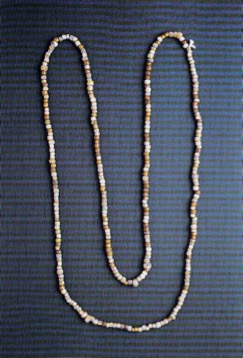Necklace with glass paste beads (Ispinigoli)
The abyss of Ispinigoli (literally "bone in the throat", named after a majestic stalactite, i.e. a column fossil, in the centre of a circular cave, which seems to lower itself from the vault in order to drive into the floor) is a karst cave located in the Supramonte of Dorgali (fig. 1), connected to the Cave of San Giovanni Su Anzu through the so-called "Abyss of the Virgins", a sinkhole about 60 metres deep with a funerary use, at the bottom of which several human bones and necklace glass paste beads of various shapes and colours have been found, some of which are defined as "fiery eyes", which made it possible to reassemble four necklaces (figs. 2, 3, 4) of alleged Punic Age (VI-III B.C.).
Over the years, several archaeological artefacts were recovered inside (pottery fragments, bronze and silver adornment objects) proving the use of the cave from at least the Nuraghic Age up until the Early Medieval Age.




Bibliografia
- PULACCHINI D., Serra Orrios e i monumenti archeologici di Dorgali, Sardegna Archeologica. Guide e itinerari, 26, Sassari 1998a, pp. 86-89.
- PULACCHINI D., Il museo archeologico di Dorgali, Sardegna Archeologica. Guide e itinerari, 27, Sassari 1998b, p. 24.

 VR
VR